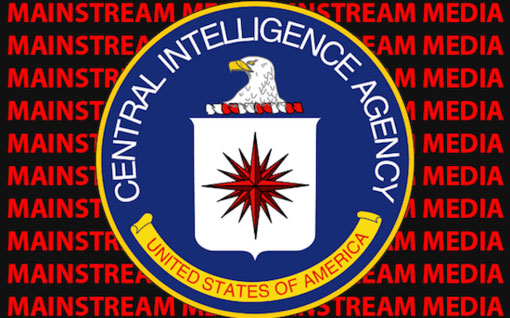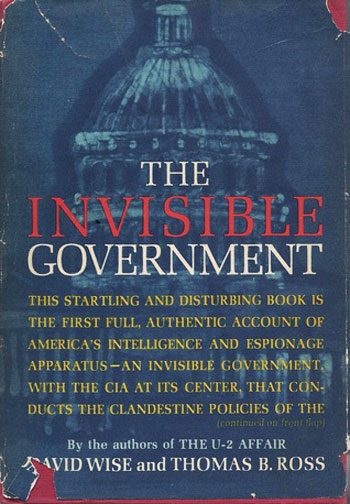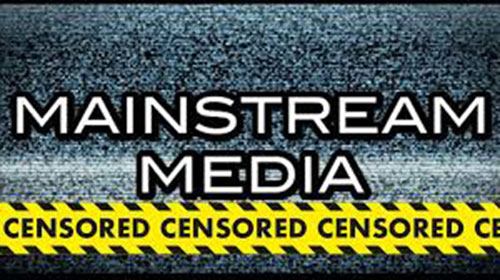50 Facts The World Needs To Know About Mainstream Media’s Relationship With The US Government (2)
Below is an article written by James F. Tracy in August of 2015, and is relevant today given all of the “fake news” campaigns that have been directed against alternative media.
Since the end of World War Two the Central Intelligence Agency has been a major force in US and foreign news media, exerting considerable influence over what the public sees, hears and reads on a regular basis. CIA publicists and journalists alike will assert they have few, if any, relationships, yet the seldom acknowledged history of their intimate collaboration indicates a far different story–indeed, one that media historians are reluctant to examine.
The following historical and contemporary facts, by no means exhaustive, provides a glimpse of how the power such entities possess to influence if not determine popular memory and what respectable institutions deem to be the historical record.

Read the first part of the article
18. Angleton, who oversaw the Agency counterintelligence branch for 25 years, “ran a completely independent group entirely separate cadre of journalist operatives who performed sensitive and frequently dangerous assignments; little is known about this group for the simple reason that Angleton deliberately kept only the vaguest of files.” Bernstein, The CIA and the Media.
19. The CIA conducted a “formal training program” during the 1950s for the sole purpose of instructing its agents to function as newsmen. “Intelligence officers were ‘taught to make noises like reporters,’ explained a high CIA official, and were then placed in major news organizations with help from management. These were the guys who went through the ranks and were told ‘You’re going to he a journalist,’ the CIA official said.” “The Agency’s preference, however, was to engage journalists who were already established in the industry.” Bernstein, The CIA and the Media.
20. Newspaper columnists and broadcast journalists with household names have been known to maintain close ties with the Agency. “There are perhaps a dozen well known columnists and broadcast commentators whose relationships with the CIA go far beyond those normally maintained between reporters and their sources,” Bernstein maintains. “They are referred to at the Agency as ‘known assets’ and can be counted on to perform a variety of undercover tasks; they are considered receptive to the Agency’s point of view on various subjects.” Bernstein, The CIA and the Media.
21. Frank Wisner, Allen Dulles, and Washington Post publisher Phillip Graham were close associates, and the Post developed into one of the most influential news organs in the United States due to its ties with the CIA. The Post managers’ “individual relations with intelligence had in fact been the reason the Post Company had grown as fast as it did after the war,” Davis (172) observes.
“Their secrets were its corporate secrets, beginning with MOCKINGBIRD. Phillip Graham’s commitment to intelligence had given his friends Frank Wisner an interest in helping to make the Washington Post the dominant news vehicle in Washington, which they had done by assisting with its two most crucial acquisitions, the Times-Herald and WTOP radio and television stations.” Davis, Katharine the Great:Katharine Graham and the Washington Post, 172.
22. In the wake of World War One the Woodrow Wilson administration placed journalist and author Walter Lippmann in charge of recruiting agents for the Inquiry, a first-of-its-kind ultra-secret civilian intelligence organization whose role involved ascertaining information to prepare Wilson for the peace negotiations, as well as identify foreign natural resources for Wall Street speculators and oil companies.
The activities of this organization served as a prototype for the function eventually performed by the CIA, namely “planning, collecting, digesting, and editing the raw data,” notes historian Servando Gonzalez. “This roughly corresponds to the CIA’s intelligence cycle: planning and direction, collection, processing, production and analysis, and dissemination.”
“Most Inquiry members would later become members of the Council on Foreign Relations. Lippmann would go on to become the Washington Post’s best known columnists.” Servando Gonzalez, Psychological Warfare and the New World Order: The Secret War Against the American People, Oakland, CA: Spooks Books, 2010, 50.
23. The two most prominent US newsweeklies, Time and Newsweek, kept close ties with the CIA. “Agency files contain written agreements with former foreign correspondents and stringers for both the weekly newsmagazines,” according to Carl Bernstein. “Allen Dulles often interceded with his good friend, the late Henry Luce, founder of Time and Life magazines, who readily allowed certain members of his staff to work for the Agency and agreed to provide jobs and credentials for other CIA operatives who lacked journalistic experience.” Bernstein, The CIA and the Media.
24. In his autobiography former CIA officer E. Howard Hunt quotes Bernstein’s “The CIA and the Media” article at length. “I know nothing to contradict this report,” Hunt declares, suggesting the investigative journalist of Watergate fame didn’t go far enough. “Bernstein further identified some of the country’s top media executives as being valuable assets to the agency… But the list of organizations that cooperated with the agency was a veritable ‘Who’s Who’ of the media industry, including ABC, NBC, the Associated Press, UPI, Reuters, Hearst Newspapers, Scripps-Howard, Newsweek magazine, and others.” E. Howard Hunt, American Spy:My Secret History in the CIA, Watergate, and Beyond, Hoboken NJ: John Wiley & Sons, 2007, 150.
25. When the first major exposé of the CIA emerged in 1964 with the publication of The Invisible Government by journalists David Wise and Thomas B. Ross, the CIA considered purchasing the entire printing to keep the book from the public, yet in the end judged against it. “To an extent that is only beginning to be perceived, this shadow government is shaping the lives of 190,000,000 Americans” authors Wise and Ross write in the book’s preamble. “Major decisions involving peace and war are taking place out of public view. An informed citizen might come to suspect that the foreign policy of the United States often works publicly in one direction and secretly through the Invisible Government in just the opposite direction.” Lisa Pease, When the CIA’s Empire Struck Back, Consortiumnews.com, February 6, 2014.

26. Agency infiltration of the news media shaped public perception of deep events and undergirded the official explanations of such events. For example, the Warren Commission’s report on President John F. Kennedy’s assassination was met with almost unanimous approval by US media outlets. “I have never seen an official report greeted with such universal praise as that accorded the Warren Commission’s findings when they were made public on September 24, 1964,” recalls investigative reporter Fred Cook.
“All the major television networks devoted special programs and analyses to the report; the next day the newspapers ran long columns detailing its findings, accompanied by special news analyses and editorials. The verdict was unanimous. The report answered all questions, left no room for doubt. Lee Harvey Oswald, alone and unaided, had assassinated the president of the United States.” Fred J. Cook, Maverick: Fifty Years of Investigative Reporting, G.P. Putnam’s Sons, 1984, 276.
27. In late 1966 the New York Times began an inquiry on the numerous questions surrounding President Kennedy’s assassination that were not satisfactorily dealt with by the Warren Commission. “It was never completed,” author Jerry Policoff observes, “nor would the New York Times ever again question the findings of the Warren Commission.” When the story was being developed the lead reporter at the Timesʼ Houston bureau “said that he and others came up with ‘a lot of unanswered questions’ that the Times didn’t bother to pursue. ‘I’d be off on a good lead and then somebody’d call me off and send me out to California on another story or something. We never really detached anyone for this. We weren’t really serious.’” Jerry Policoff, The Media and the Murder of John Kennedy, in Peter Dale Scott, Paul L. Hoch and Russell Stetler, eds, The Assassinations: Dallas and Beyond, New York: Vintage, 1976, 265.
28. When New Orleans District Attorney Jim Garrison embarked on an investigation of the JFK assassination in 1966 centering on Lee Harvey Oswald’s presence in New Orleans in the months leading up to November, 22, 1963, “he was cross-whipped with two hurricane blasts, one from Washington and one from New York,” historian James DiEugenio explains. The first, of course, was from the government, specifically the Central Intelligence Agency, the FBI, and to a lesser extent, the White House. “The blast from New York was from the major mainstream media e.g. Time-Life and NBC. Those two communication giants were instrumental in making Garrison into a lightening rod for ridicule and criticism. This orchestrated campaign was successful in diverting attention from what Garrison was uncovering by creating controversy about the DA himself.” DiEugenio, Preface, in William Davy, Let Justice Be Done: New Light on the Jim Garrison Investigation, Reston VA: Jordan Publishing, 1999.
29. The CIA and other US intelligence agencies used the news media to sabotage Garrison’s 1966-69 independent investigation of the Kennedy assassination. Garrison presided over the only law enforcement agency with subpoena power to seriously delve into the intricate details surrounding JFK’s murder.
One of Garrison’s key witnesses, Gordon Novel, fled New Orleans to avoid testifying before the Grand Jury assembled by Garrison. According to DiEugenio, “CIA Director Allen Dulles and the Agency would begin to connect the fugitive from New Orleans with over a dozen CIA friendly journalists who – in a blatant attempt to destroy Garrison’s reputation – would proceed to write up the most outrageous stories imaginable about the DA.” James DiEugenio, Destiny Betrayed: JFK, Cuba, and The Garrison Case, Second Edition, New York: SkyHorse Publishing, 2012, 235.
30. CIA officer Victor Marchetti recounted to author William Davy that in 1967 while attending staff meetings as an assistant to then-CIA Director Richard Helms, “Helms expressed great concerns over [former OSS officer, CIA operative and primary suspect in Jim Garrison’s investigation Clay] Shaw’s predicament, asking his staff, ‘Are we giving them all the help we can down there?’” William Davy, Let Justice Be Done: New Light on the Jim Garrison Investigation, Reston VA: Jordan Publishing, 1999.
31. The pejorative dimensions of the term “conspiracy theory” were introduced into the Western lexicon by CIA “media assets,” as evidenced in the design laid out by Document 1035-960 Concerning Criticism of the Warren Report, an Agency communiqué issued in early 1967 to Agency bureaus throughout the world at a time when attorney Mark Lane’s Rush to Judgment was atop bestseller lists and New Orleans DA Garrison’s investigation of the Kennedy assassination began to gain traction.
32.
Time had close relations with the CIA stemming from the friendship of the magazine’s publisher Henry Luce and Eisenhower CIA chief Allen Dulles. When former newsman Richard Helms was appointed DCI in 1966 he “began to cultivate the press,” prompting journalists toward conclusions that placed the Agency in a positive light. As Time Washington correspondent Hugh Sidney recollects, “‘with John McCone and Richard Helms, we had a set-up when the magazine was doing something on the CIA, we went to them and put it before them. We were never misled.’ Similarly, when Newsweek decided in the fall of 1971 to do a cover story on Richard Helms and ‘The New Espionage’ the magazine, according to a Newsweek staffer, went directly to the agency for much of the information. And the article generally reflected the line that Helms was trying so hard to sell: that since the latter 1960s the focus of attention and prestige within CIA’ had switched from the Clandestine Services to the analysis of intelligence, and that ‘the vast majority of recruits are bound for’ the Intelligence Directorate.” Victor Marchetti and John D. Marks, The CIA and the Cult of Intelligence, New York: Alfred A. Knopf, 1974, 362-363.

33. In 1970 Jim Garrison wrote and published the semi-autobiographical A Heritage of Stone, a work that examines how the New Orleans DA “discovered that the CIA operated within the borders of the United States, and how it took the CIA six months to reply to the Warren Commission’s question of whether Oswald and [Jack] Ruby had been with the Agency,” Garrison biographer and Temple University humanities professor Joan Mellen observes. “In response to A Heritage of Stone, the CIA rounded up its media assets” and the book was panned by reviewers writing for the New York Times, the Los Angeles Times, the Washington Post, the Chicago Sun Times, and Life magazine.
“John Leonard’s New York Times review went through a metamorphosis,” Mellen explains. “The original last paragraph challenged the Warren Report: ‘Something stinks about this whole affair,’ Leonard wrote. ‘Why were Kennedy’s neck organs not examined at Bethesda for evidence of a frontal shot? Why was his body whisked away to Washington before the legally required Texas inquest? Why?’ This paragraph evaporated in later editions of the Times.
A third of a column gone, the review then ended: ‘Frankly I prefer to believe that the Warren Commission did a poor job, rather than a dishonest one. I like to think that Garrison invents monsters to explain incompetence.’” Joan Mellen, A Farewell to Justice: Jim Garrison, JFK’s Assassination, and the Case That Should Have Changed History, Washington DC: Potomac Books, 2005, 323, 324.
34. CIA Deputy Director for Plans Cord Meyer Jr. appealed to Harper & Row president emeritus Cass Canfield Sr. over the book publisher’s pending release of Alfred McCoy’s The Politics of Heroin in Southeast Asia, based on the author’s fieldwork and Yale PhD dissertation wherein he examined the CIA’s explicit role in the opium trade. “Claiming my book was a threat to national security,” McCoy recalls, “the CIA official had asked Harper & Row to suppress it. To his credit, Mr. Canfield had refused. But he had agreed to review the manuscript prior to publication.” Alfred W. McCoy, The Politics of Heroin: CIA Complicity in the Global Drug Trade, Chicago Review Press, 2003, xx.
Read the third part of the article
yogaesoteric
March 15, 2019
